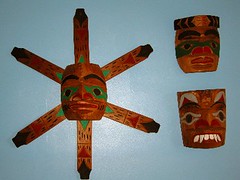A Chief on a Beach and then Some
A particularly good but sappy Extreme Makeover: Home Edition was on a couple days ago. In it, a Native American woman (Lori Piestewa) who was the first military female killed in action in Iraq, has her dream come true posthumously when Pvt. Jessica Lynch, Piestewa’s roomie and best friend, hooks up her family with a new home on the first plot of land they’d ever owned.
During the show, they spoke a lot about the Navajo Windtalkers in WWII, and a bit about the culture. (They skirted Native treatment at the hands of whites, et al, of course, but it’s a start.)
I’ve always had a huge respect for Native faiths. Profound admiration for their mentality and their awe-inspiring love of the land and everything Mother Earth has to offer. I don’t know why, but it just makes me feel better that some people feel that powerfully connected to the natural world around us. I’ll always feel like Native Indians were North America’s greatest tragedy. What a fucking crime.
But I’m off my soapbox now.
One of coolest, most amazing experiences I’ve ever had was when I was invited into a traditional Native sweat ceremony in the Yukon. (Another story for another time.) Phil was a Tlingit Chief and believed that it was important to include whites and non-Natives in their ceremony, to teach others about the beauty that was their culture, and in the teachings they’d somehow help the legacy of their beliefs carry on and spread.
I’ve only ever been in one other sweatlodge ceremony, and that was down here in Vancouver, at the Burrard Nation’s land. They both blew my mind, and they were both completely different in how they affected me.
My sweat lodge experience opened my eyes further to Native culture, but I’d always had a softness for it. One of the books that always sat around my home was Bury My Heart at Wounded Knee, about the Wounded Knee massacre. It always struck me so tragic, and I never dared to read it. My mother, though, always had a strong attachment to Native faiths, and though it took a long time to understand the deeper reasons why, I definitely respected Mom’s feelings on it even when I was little.
When I was a kid, there was a dude in White Rock, my hometown, named Chief Nick (as shown in charcoal sketch below). He was an alcoholic and a chief in the Nootka tribe here in BC, but he’d left his hometown and was living in White Rock, where he had more dryspells than wet ones. To get by, you’d find him down on the beautiful beaches of White Rock, carving traditional Nootka masks that he’d sell to tourists and locals (pictured in above inset).
My parents loved anything Native, and before long, I found myself the summer of my sixth or seventh year with this Native Indian chief sitting in my basement, carving mask after mask and even making a totem pole or two.
I don’t remember a lot about Nick, but I remember his amazingly positive, easy-going attitude. It seemed he’d had a really hard and tragic life, full of oppression and difficulty, but he never lost his smile.
Still, I found the big burly Indian man a little frightening, and being as he always held really sharp instruments in his hands, and I was an imaginative child, I would always scurry on past him. I just remember him hunkered down on a chair in the centre of the concrete-floored room, hammering and chiselling away, wood chips spitting side to side, splinters sticking in my flip-flops, bits of wood entangling in my then-long hair. Sawdust caking on the big dark man's skin, thicker clumps of it on the back of his wrists and on the tops and insides of his thighs. He'd have a bottle of booze in a paper bag if my mother wasn't around, and would swig a little as he leaned back and scrutinized his work. When he'd set the bottle down again, he'd be right back in another fury of carving.
But I'd watch him through the open carport door, nearby the hedges in the yard, pretending to play at the head of the driveway.
And it was always the same-- hammer, hammer, hammer. Chisel, chisel, chisel. Furrowing under his ever-present plastic late-'70s aviator-style shades.
I’m 31 now, and more than two decades later, I’ve still got Nick’s art around. The photo you see above is the cluster of masks I have of Nick’s. The charcoal drawing was a portrait of Nick drawn by a local artist. Nick autographed it. :)
For a long time there, Nick on the beach in White Rock was one of the coolest things about my hometown, and I think he became a much-loved local figure when he wasn’t drinking, but I don’t know what ever happened to the man. And I wish I did.
From time to time, I’ll probably talk a bit more about my attachment to Native faiths. They’re just so cool. Who the hell decides that, in order to worship “God,” you gotta stand inside a manmade building? Go stand in the valley between a couple mountains, in a forest, on an ocean, under the stars, in the night-time staring at Northern Lights-- anywhere but inside of four fucking walls slapped with a coat of Home Depot paint. You wanna find God? Get the hell outdoors.
Like the Natives did. But it reminds me of a legend about a town in BC’s interior, the real Valley of the Lost Souls. I’ll write of that sometime in the week to come.
(Shamus, did you know of Nick?)





<< Home